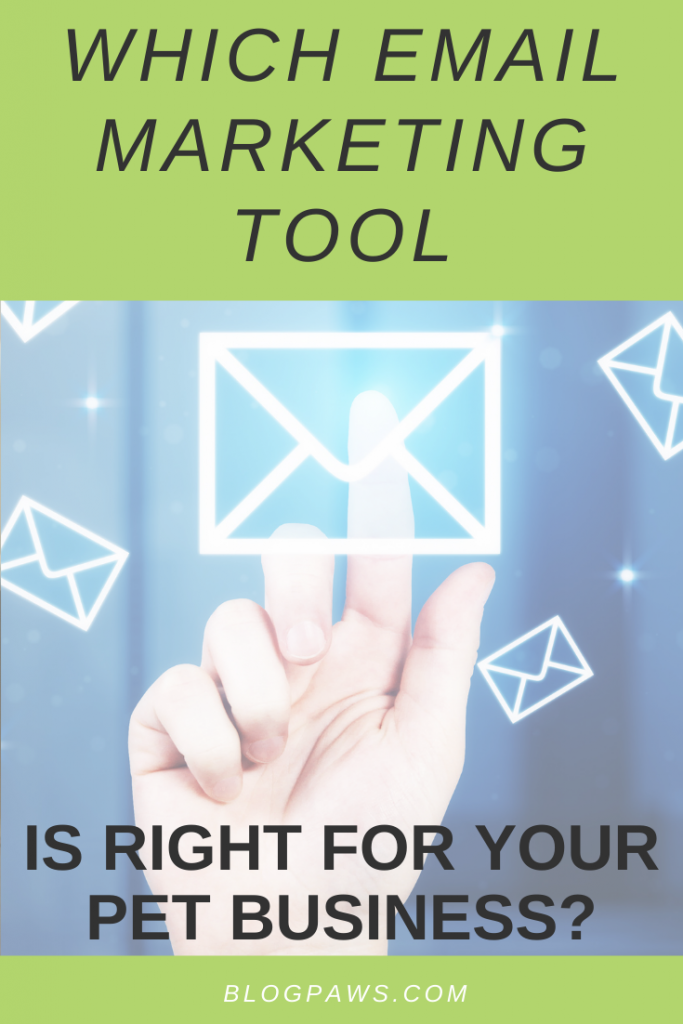Email marketing is one of the oldest forms of marketing, at least when it comes to the age of digital marketing. The very first email campaign was sent over 41 years ago on May 3, 1978 by the marketing manager of Digital Equipment Corporation, Gary Thuerk. He sent it to 400 users to promote a new DEC computer. That one email resulted in sales of $13 million. Today, that would be over $50 million in sales from one email.
Fast forward to today and there are over 293 billion emails exchanged per day. Probably more since that stat is from a report from The Radicati Group in 2019.
Before you start leveraging email marketing tactics, you need to pick the tool you will use. It’s worth spending some time researching the tools and making sure you can get what you need from it before making your decision.

FIVE EMAIL MARKETING TOOLS FOR SMALL BUSINESS
There are many different tools out there, and if you think one on this list is a possibility, remember to do a little extra research before making that decision. We focus on four tools that have a free level to start, and one that specializes in ecommerce. However, just because a tool is free does not mean it’s the tool for you. You want to find the service that you can grow into. While you can always change your tool, it’s easier to grow with the one you know.
- Sendinblue has a free plan with unlimited contacts and up to 300 emails per day. The free plan does not however have some nice features like A/B testing and the ability to remove the Sendinblue logo. The free standout: unlimited contacts.
Move up to the Lite plan starting at $25/month and you get those features and 10,000 emails a day. No more daily sending limit. As you add emails your price goes up, but you also get more advanced stats with a paid plan.
The premium plan starts at $65/month and adds in landing pages, Facebook and retargeting ads, and better support.
- Mailchimp has a free plan that allows for up to 2,000 contacts and one audience. That means one list to send your emails to. In other words, no segmenting. You can add tags for tracking purposes, but not for sending purposes. One nice thing about Mailchimp is that the free plan includes landing pages and Facebook and Instagram Ads with social posting. The free standout: social ads and posting.
Move up to the Essentials plan starting at $9.99/month and you can have 50,000 contacts and three audiences. You also get more templates, custom branding, A/B testing, and better support.
The Standard plan starts at $14.99/month for up to 100,000 contacts and five audiences. Plus, many more custom features like a customer journey builder, send time optimization, behavioral targeting, custom templates, and dynamic content. These additions are only fancy if you use them, though, and that takes some education or hiring an email marketing consultant.
- Convertkit also has a free plan that allows up to 1,000 subscribers (same thing as a contact) and, like Mailchimp, includes landing pages. It also has a special sales pages feature. The free standout: unlimited landing and sales pages.
Move up to the Creator plan that starts at $29/month and you add features, but not subscribers. You can add subscribers, but it will increase the price. The new features are migration assistance and automated funnels and sequences.
The Creator Pro plan starts at $59/month, and again, doesn’t add more than those first 1,000 subscribers without adding cost, but does add Facebook custom audiences, a newsletter referral system, subscriber scoring, and advanced reporting.
- Aweber has a free plan that allows up to 500 subscribers and 3,000 emails per month, but only 1 email list. It does include some email automation tools, a drag-and-drop email builder, landing pages, basic segmentation, dynamic content (worth saying it’s the only service we found that offers dynamic content at the free level), and thousands of professional images – another tool not offered by other services. The free standout: dynamic content and image database.
Move up to the Pro plan starting at $16.15/month for up to 500 subscribers and you can add split testing, behavioral automation, your branding, custom segmentation, advanced analytics and ecommerce solutions. However, when you get up to 5,001-10,000 subscribers, your cost goes up to $69/month.
- That brings us to Drip. Drip does not have a free plan, but we wanted to share it because it is the plan most customized for ecommerce selling. If ecommerce is your jam, then Drip may be your bread.
Drip’s cost is based on the number of people you have in your account, which is your subscribers. 100 people starts at $19/month and up to 5,000 is $89/month. Drip’s automation and segmentation tools are a big benefit to ecommerce businesses. It will track revenue attribution, offers SMS, has both behavior and event tracking tools to help you make sense of its detailed email analytics, and it has many third-party integrations. Its benefit to ecommerce tools made us feel it was a worthy tool to include, even though it has no free level.
HOW TO MAKE A DECISION ABOUT AN EMAIL MARKETING TOOL
Keep in mind that when you start with a new email marketing tool and upload a list, there will be a verification process to prove that the people whose emails you uploaded actually opted into your list. It can be frustrating to take this step, but it does help prevent spammers from uploading purchased lists. Every service will do some form of this, so it shouldn’t affect your decision, but it will affect how quick you can start sending emails.
In the end, you have to decide how you want to use email marketing. Here are some questions to ask yourself:
- How do you want users to opt into your list(s)?
- Will you want landing pages within your email marketing tool? (Or will you use landing pages created on your site?)
- What kind of integration tools might you need for your business?
- Will you have one general newsletter to send to a very niche audience and so less segmentation needed?
- Or is your audience diverse and segmentation is part of your personalization plan?
- Do you plan to have events and want to track those separately?
- Do you want to sell through your emails?
- What is the subscriber number you hope to grow your list to?
- Will you want to retarget your subscribers on Facebook?
- What else do you plan to do with your business? You do not need to figure out all of the “how” right now, but knowing it’s possible in the future will make the integration easier.
Think into the future of your business, and do your best to find the tool that can help your business reach that future. Start with that tool and grow together.
What tool are you using currently? Do you like it or wish it did more?


